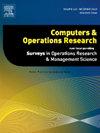Relax-and-Fix and Fix-and-Optimise algorithms to solve an integrated network design problem for closing a supply chain with hybrid retailers/collection centres
IF 4.1
2区 工程技术
Q2 COMPUTER SCIENCE, INTERDISCIPLINARY APPLICATIONS
引用次数: 0
Abstract
This paper studies a multi-echelon closed-loop supply chain network design problem that is characterised by a set of hybrid retailers/collection centres in a multi-period setting. This problem is motivated by the return-to-retail approach currently prevalent in the retail industry under the deposit return scheme. This paper proposes a mathematical programming model that integrates strategic decisions regarding the number and location of hybrid retailer/collection centre facilities, with dynamic decisions pertaining to manufacturing and remanufacturing/recycling, inventory level, and fleet size across the network. This optimisation problem is formulated as a mixed integer linear programming model to fulfil customers’ demands while minimising the total network costs. To solve the problem, a matheuristic solution approach is devised, incorporating Relax-and-Fix and Fix-and-Optimise heuristics augmented by novel relaxation and fixing strategies. We introduce an integrality test which accounts for possible rounding-off errors allowing a user-defined integer feasibility tolerance. Moreover, a variable partitioning is applied to shrink the problem’s dimensions and to shorten the search space. The latter is then iteratively updated to explore neighbourhoods within a given search radius size. To evaluate the validity and efficiency of the proposed model and the solution approach, 90 instances are generated using a case study within the geographical scope limited to the network of a retail chain in France. Numerical results show that the proposed solution method provides near-optimal solutions for small- and medium-size instances in a reasonable computational time and outperforms the commercial solver for large- and extra large-size problems. Managerial insights derived from the computational experiments regarding key performance indicators of the problem are presented and discussed.
放松-修复和修复-优化算法,以解决与混合零售商/收集中心关闭供应链的集成网络设计问题
本文研究了一个多周期环境下多级闭环供应链网络设计问题,该问题具有一组混合零售商/收集中心的特征。这一问题的动机是目前在存款返还计划下零售业盛行的回归零售方式。本文提出了一个数学规划模型,该模型集成了关于混合零售商/收集中心设施的数量和位置的战略决策,以及关于制造和再制造/回收、库存水平和整个网络的车队规模的动态决策。这个优化问题被表述为一个混合整数线性规划模型,以满足客户的需求,同时最小化总网络成本。为了解决这个问题,设计了一种数学解决方法,结合了放松-修复和修复-优化启发式,并辅以新的放松和固定策略。我们引入了一个完整性测试,它考虑了可能的舍入误差,允许用户定义的整数可行性容限。此外,还采用了变量划分来缩小问题的维数,缩短搜索空间。然后迭代更新后者以探索给定搜索半径大小内的邻域。为了评估所提出的模型和解决方案方法的有效性和效率,在法国一家零售连锁店网络的地理范围内,使用案例研究生成了90个实例。数值结果表明,所提出的求解方法在合理的计算时间内为中小型实例提供了近似最优解,并且在求解大型和超大规模问题时优于商用求解器。提出并讨论了从计算实验中得出的关于问题关键绩效指标的管理见解。
本文章由计算机程序翻译,如有差异,请以英文原文为准。
求助全文
约1分钟内获得全文
求助全文
来源期刊

Computers & Operations Research
工程技术-工程:工业
CiteScore
8.60
自引率
8.70%
发文量
292
审稿时长
8.5 months
期刊介绍:
Operations research and computers meet in a large number of scientific fields, many of which are of vital current concern to our troubled society. These include, among others, ecology, transportation, safety, reliability, urban planning, economics, inventory control, investment strategy and logistics (including reverse logistics). Computers & Operations Research provides an international forum for the application of computers and operations research techniques to problems in these and related fields.
 求助内容:
求助内容: 应助结果提醒方式:
应助结果提醒方式:


